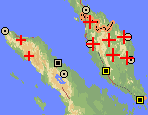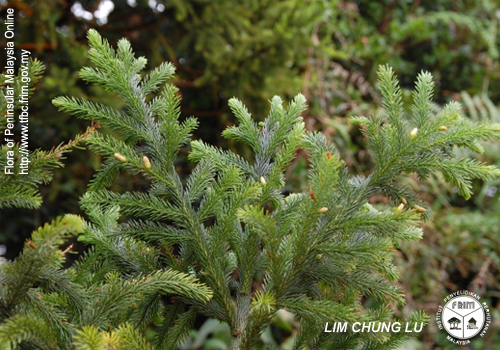Dacrydium medium, first described by David de Laubenfels in 1976, is commonly known as Sangu or Gajo. It is an evergreen coniferous shrub in the Podocarpaceae family typically growing 3 feet (1 m) tall or occasionally into a small, often gnarled tree, sometimes up to 60 feet (20 m) tall. Its dense branching forms a compact oval shape. Juvenile leaves spread widely but sometimes distinctly curve forward so that the spiny apex is more or less parallel to the branch, lanceolate, up to 0.8 inch (20 mm) long, strongly keeled on three sides, and nearly flat on the axial surface. Adult leaves on younger trees nearly straight and up to 0.3 inch (8 mm) long but with greater age the leaves become shorter and sharply curved forward or even slightly inward, spiny, linear-lanceolate, 0.17 inch (3-6 mm) long but nearly uniform on a branch. Fertile structures mostly terminal. Pollen cones with basal leaves hardly different from foliage leaves, 0.3 inch (7 - 9 mm) long and 0.1 inch (2.5 mm) in diameter. Seed-bearing structure subtended by a zone of reduced leaves about 0.08 (2 mm) long, the cone bracts longer and partly covering the seed. The brown seeds about 0.2 inch (5 mm) long.

Distribution. This species is native to Malaysia (G. Tahan complex) and northern Sumatra (Gajo Lands: G. Leuser & Bandahara), rising above and often dominant in low mountain scrub on what appears to be rather poor soils between 3,000 and 6800 feet (960 and 2100 m) elevation in Malaysia and 5,700 to 8,300 feet (1,800 - 2,600 m) in Sumatra.
